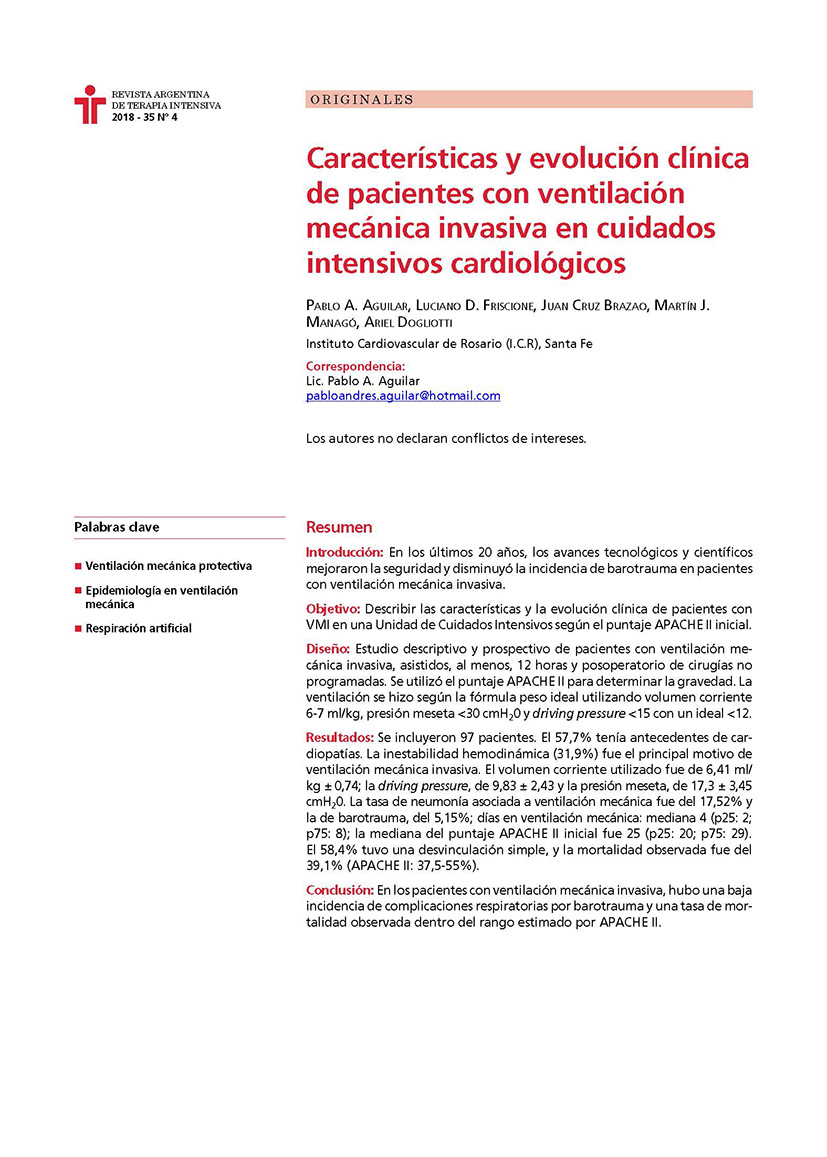CARACTERÍSTICAS Y EVOLUCIÓN CLÍNICA DE PACIENTES CON VENTILACIÓN MECÁNICA INVASIVA EN CUIDADOS INTENSIVOS CARDIOLÓGICOS.
Main Article Content
Abstract
Introducción: En los últimos 20 años los avances tecnológicos y científicos mejoraron la seguridad y disminuyó la incidencia de barotrauma en pacientes con ventilación mecánica invasiva (VMI).
Objetivo: Describir las características y evolución clínica de pacientes con ventilación mecánica invasiva en una unidad de cuidados intensivos cardiológicos según score Apache II inicial y estrategia de ventilación protectiva.
Diseño: Se realizó un estudio de cohorte donde se relevaron prospectivamente los pacientes en ventilación mecánica invasiva con al menos 12 horas de VMI y postoperatorio de cirugías no programadas. Los pacientes fueron ventilados según fórmula de peso ideal, volumen corriente (VC) 6-7ml/kg, presión meseta <30 cmH20 y “driving pressure” <15 con un ideal <12.
Resultados: De 296 pacientes con ventilación mecánica invasiva, se incluyeron 97 que cumplieron los criterios de inclusión. Las patologías cardiológicas representaron el 57,70% de los motivos de ingreso a cuidados intensivos; y la inestabilidad hemodinámica fue la principal causa de ventilación mecánica con 31,95%. El VC utilizado fue 6,41 ml/kg +/- 0,74 (p= 0,04); “driving pressure” de 9,83 +/- 2,43; presión meseta 17,3 +/- 3,45 cmH20; barotrauma 5,15%; días en ventilación mecánica 6 +/- 5,23; score Apache II inicial 23,02 +/- 9,84; la desvinculación simple se presentó en 58,46% y la mortalidad general fue 39,1%.
Conclusión: En los pacientes que recibieron ventilación mecánica invasiva se observó una baja incidencia de complicaciones respiratorias por barotrauma y la mortalidad se encuadra dentro de lo esperado según el score Apache II de nuestros pacientes.
Article Details
The magazine does not retain the reproduction rights (copyright) so the authors can republish their works with the sole mention of the original publication source.
References
Anuj Mehta, Sohera N Syeda, Renda Soylemez Wiener. Epidemiological Trends in Invasive Mechanical Ventilation in the United States: A Population-Based Study. Crit Care. 2015 December; 30(6): 1217–1221.
Kacmarek R. The Mechanical Ventilator: Past, Present, and Future. Respiratory care. August 2011 Vol 56 Nº 8.
Serpa Neto A, Oliveira Cardoso S, Manetta J, Moura Pereyra G, Esposito Crepaldi D. Association between Use of Lung-Protective Ventilation With Lower Tidal Volumes and Clinical Outcomes Among patients Without Acute Respiratory Distress Syndrome. Jama October 2012;24:31. Vol 308, Nº16.
Amato M, Barbas Valente S, Medeiros Mechado B, Borges Magaldi R, Schettino Pinto P. Effect of a protective-ventilation strategy on mortality in the acute respiratory distress sÃndrome. New England Journal of Medicine 1998;338:347-54.
The acute respiratory distress sÃndrome network. Ventilation with lower tidal volumes as compared ith traditional tidal volumes for acute lung injury and the acute respiratory distress syndrome. New England Journal of Medicine 2000;342:1301-8.
Knauss W, Drapper E, Wagner D, Zimmerman J. Apache II: A severity of a disease classification system. Critical Care of Medicine 1985. Vol 13, Nº10.
Béduneau G, Pham T, Schortgen F, Piquilloud L, Brochard L. Epidemiology of weaning outcome according to a new definition. The WIND study. American Thoracic Society 2016 0.1164/rccm.201602-0320OC.
Nazir I, Walsh L, Walsh T. Prolonged mechanical ventilation in critically ill patients: epidemiology, outcomes and modelling the potential cost consequences of establishing a regional weaning unit. Critical Care 2011,15:R102.
Ferrer M, Valencia M, Bernadich O, Badia JR, Torres A. Early Noninvasive Ventilation Averts Extubation Failure in Patients at Risk. Respir Crit Care Med Vol 173. pp 164–170, 2006.
De Prost N, Dreyfuss D. How to prevent ventilator-induced lung injury? Minerva anestesiologÃa. Vol 78, Nº9. Pag 1054-1066.
Meade O, Cook JD, Guyatt G. Ventilation strategy using low tidal volumes recruitment maneuvers, and High Positive end-expiratory pressure for acute lung Injury and Acute Respiratory Distress Syndrome. Jama. 2008;299(6):637-645 (doi:10.1001/jama.299.6.637).
Brochard L, Roudot –Thoraval F. Roupie E, Delclaux C, Chastre J. Tidal volume reduction for prevention of ventilator-induced lung injury in acute respiratory distress syndrome. respir crit care med 1998;158:1831–1838.
Carpenter C, Drewry A, Mohr N, Fuller B. Lower tidal volume at initiation of mechanical ventilation may reduce progression to acute respiratory distress syndrome – a systematic review. Critical Care 2013, 17:R11 doi:10.1186/cc11936.
Schultz M, Haitsma J, Slutsky A, Gajic O. What Tidal Volumes Should Be Used in Patients without Acute Lung Injury?. Anesthesiology 2007; 106:1226–31.
Sutherasan Y, Vargas M, Pelosi P. Protective mechanical ventilation in the non-injured lung: review and meta-analysis. Critical Care 2014, 18:211.
Pannu S.R, Hubmayr RD. Safe mechanical ventilation in patients without acute respiratory distress syndrome (ARDS). Minerva anestesiologica. September 2015. Vol. 81 - No. 9.
Fuller B, Mohr N, Drewry A, Carpenter C. Lower tidal volume at initiation of mechanical ventilation may reduce progression to acute respiratory distress sÃndrome. Critical Care 2013, 17:R11.
Esteban A, Frutos Vivar F, Muriel A, Peñuelas O, Abraira V, Raymondos K. Evolution of Mortality over Time in Patients Receiving Mechanical Ventilation. Respir Crit Care Med Vol 188, Iss. 2, pp 220–230, Jul 15, 2013.
Esteban A, Anzueto A, Frutos Vivar F, AlÃa I, Brochard L, Benito S. Characteristics and outcomes in adult patients receiving mechanical ventilation a-28-Day international study. Jama, January 16, 2002—Vol 287, No. 3.
Fialkow L, Farenzena M, Wawrzeniak C, Brauner J, Vigo A, BozzettiI MC. Mechanical ventilation in patients in the intensive care unit of a general university hospital in souther Brazil: an epidemiological study. Clinics 2016;71(3):145-151.
Niewiński G, Starczewska M, Kański A. Prognostic scoring systems for mortality in intensive care units — The APACHE model. Anaesthesiol Intensive Ther 2014, vol. 46, no 1, 46–49.

